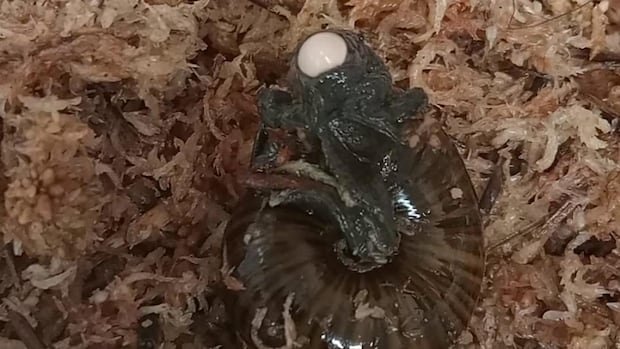
After a dozen years dedicated to studying a rare species of carnivorous snail, Lisa Flanagan was thrilled to finally film the moment that, until recently, had been shrouded in mystery.
Flanagan, a ranger at the New Zealand Department of Conservation, was weighing a Powelliphanta augusta snail when she saw what looked like a tiny hen’s egg emerging from a small opening beneath its head.
“It was just one of those things that was just a fluke,” Flanagan told As It Happens host Nil Köksal. “He happened to be laying the egg at that time.”
Powelliphanta augusta snails take eight years to reach sexual maturity, after which they lay about five eggs a year, through an opening in their neck. But, despite almost two decades of caring for the critters in chilled containers at a facility in Hokitika, N.Z., staff had never witnessed this unfold until that fateful moment on May 7.
The whole thing took just under one minute, Flanagan says.
Lisa Flanagan, a ranger at New Zealand’s Department of Conservation, filmed the moment the Powelliphanta augusta snail laid its egg from the genital pore in the side of its neck. (Credit: New Zealand Department of Conservation)
The footage, she says, confirms certain details about these snails’ reproductive cycle, while prompting new ones for those who work with the creatures.
In the clip, as the egg emerges, a baffled Flanagan can be heard saying to her colleague: “I wonder if it hurts.”
Meet one of the world’s largest carnivorous snails
The dozens of species and subspecies of Powelliphanta snails are only found in New Zealand, mostly in rugged forest and grassland settings, where they are threatened by habitat loss.
At roughly nine centimetres in length, the Powelliphanta augusta is one of the largest carnivorous snails in the world, known to slurp up earthworms like noodles.
Even observing their eating habits has been a rarity for Flanagan. Although they are fed monthly, in the 12 years of looking after these snails, she and her colleagues had only seen them gulp a worm three or four times.

The Powelliphanta augusta was the centre of public uproar and legal proceedings in the early 2000s, when coal mining company Solid Energy threatened to destroy the snails’ only habitat on the Mount Augustus ridge line.
Some 4,000 were removed from the site and relocated, while 2,000 more were housed in chilled storage in the West Coast town of Hokitika to ensure the preservation of the species, which is slow to breed and doesn’t adapt well to new habitats.
In 2011, some 800 of the snails accidentally died in a Department of Conservation refrigerator with faulty temperature control. But the species’ slow survival continues: In March this year, there were nearly 1,900 snails and nearly 2,200 eggs in captivity, the conservation agency said.
Why the neck?
While reproducing from the side of the neck may seem odd, it is, in fact, par for the course for snails.
That’s because they are encased in protective shells that allow them to retreat from predators and poor weather conditions.
This evolutionary trait, however, can also cause complications, like how to mate with other snails and successfully reproduce, says Kath Walker, the N.Z. Department of Conservation’s senior science adviser.
“Powelliphanta have solved this by having an opening (a genital pore) on the right side of their body just below their head,” Walker said in a press release.
Like other snails, Powelliphanta augusta are hermaphrodites. So, in order to mate, the invertebrate uses the genital pore to simultaneously exchange sperm with another snail, which is stored until each creates an egg.
“The snail only needs to peek out of its shell to do the business,” Walker said.
While most snails lay eggs, some reproduce through live birth — also via their neck.
Last July, the Campbell keeled glass-snail was captured on video as birthing offspring at Taronga Zoo in Sydney, Australia. The video shows a mini snail — shell, tentacles, and all — slipping out of its parent’s neck.
Flanagan said that it is common for Powelliphanta augusta snail eggs to take, on average, 400 days to hatch. When the day finally arrives, she said it “just hatches out as a little tiny wee snail.”
She says she hopes her own video out of Hokitika shows others how amazing these snails are.
“People sort of tend to think it’s not like, you know, a fluffy little kiwi or a penguin or something like that. It’s just a snail. But no, they’re there for a reason,” she said.
“People don’t understand how cool they are and the things that they do.”






